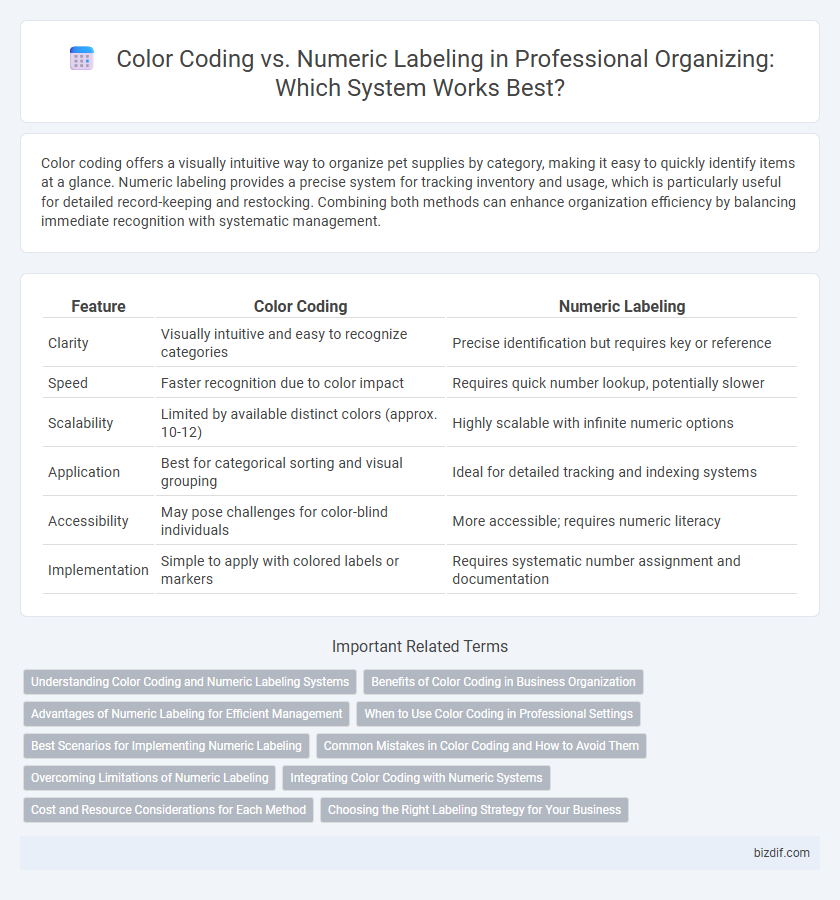Color coding offers a visually intuitive way to organize pet supplies by category, making it easy to quickly identify items at a glance. Numeric labeling provides a precise system for tracking inventory and usage, which is particularly useful for detailed record-keeping and restocking. Combining both methods can enhance organization efficiency by balancing immediate recognition with systematic management.
Table of Comparison
| Feature | Color Coding | Numeric Labeling |
|---|---|---|
| Clarity | Visually intuitive and easy to recognize categories | Precise identification but requires key or reference |
| Speed | Faster recognition due to color impact | Requires quick number lookup, potentially slower |
| Scalability | Limited by available distinct colors (approx. 10-12) | Highly scalable with infinite numeric options |
| Application | Best for categorical sorting and visual grouping | Ideal for detailed tracking and indexing systems |
| Accessibility | May pose challenges for color-blind individuals | More accessible; requires numeric literacy |
| Implementation | Simple to apply with colored labels or markers | Requires systematic number assignment and documentation |
Understanding Color Coding and Numeric Labeling Systems
Color coding enhances visual organization by associating specific colors with categories, making it easier to identify and retrieve items quickly in professional organizing. Numeric labeling assigns a unique number to each item or category, enabling precise tracking and systematic arrangement, especially useful in inventory management. Combining both systems can optimize efficiency by leveraging the intuitive recognition of colors alongside the accuracy of numeric references.
Benefits of Color Coding in Business Organization
Color coding enhances visual recognition and speeds up retrieval processes in business organization by allowing employees to quickly identify categories and priorities. This system reduces errors associated with mislabeling and improves workflow efficiency through intuitive categorization. Incorporating color coding supports consistency and fosters better communication across teams by providing an easily interpretable organizational structure.
Advantages of Numeric Labeling for Efficient Management
Numeric labeling enhances efficient management by providing a clear, scalable system that simplifies inventory tracking and retrieval across diverse categories. Unlike color coding, numeric labels minimize confusion in complex environments, allowing for precise identification and quick updates as items or data change. This method supports seamless integration with digital systems, improving overall organization accuracy and workflow productivity.
When to Use Color Coding in Professional Settings
Color coding in professional organizing excels in environments requiring quick visual identification, such as filing systems and inventory management, where distinct hues enhance efficiency and reduce errors. This method is particularly effective in collaborative spaces, as colors provide an intuitive, universally understandable reference that transcends language barriers. Use color coding when categorization by priority, status, or type improves workflow clarity and accelerates task execution.
Best Scenarios for Implementing Numeric Labeling
Numeric labeling excels in environments requiring precise inventory tracking or complex categorization, such as warehouses and archival systems. It enhances efficiency by minimizing errors and streamlining retrieval processes when dealing with extensive or similar-looking items. This method is particularly beneficial for professionals managing large-scale projects, client files, or detailed logistics, where clear, scalable organization is critical.
Common Mistakes in Color Coding and How to Avoid Them
Common mistakes in color coding include using too many similar shades, which can cause confusion and reduce efficiency, and relying solely on colors without clear labels, making it inaccessible for color-blind individuals. To avoid these issues, implement a limited, high-contrast color palette combined with numeric labeling or clear symbols to enhance clarity and universal understanding. Consistently applying both color and numeric systems improves organization and minimizes errors in professional settings.
Overcoming Limitations of Numeric Labeling
Color coding enhances organizational systems by leveraging visual memory, making it easier to identify categories at a glance compared to numeric labeling, which can be abstract and less intuitive. Numeric labels often require referencing a separate key, slowing down retrieval and increasing the risk of errors, while color coding streamlines the process through immediate recognition. Integrating color coding with numeric systems mitigates the limitations of purely numeric labels by combining clarity with precision, improving efficiency in professional organizing.
Integrating Color Coding with Numeric Systems
Integrating color coding with numeric labeling enhances organizational efficiency by combining intuitive visual cues with precise identification. This hybrid system supports faster item retrieval and reduces errors in environments like warehouses, libraries, and offices. Employing contrasting colors alongside sequential numbers optimizes both cognitive recognition and systematic cataloging for streamlined workflow management.
Cost and Resource Considerations for Each Method
Color coding requires purchasing various colored labels or markers, which can increase upfront costs but simplifies visual sorting and reduces time spent searching. Numeric labeling demands fewer supplies, often just labels or tags with printed numbers, making it a more budget-friendly option but may require additional time investment in maintaining a reference key or system. Both methods vary in resource allocation depending on the scale of organization and available tools, with color coding favoring quick visual recognition and numeric labeling offering precision with minimal material expenditure.
Choosing the Right Labeling Strategy for Your Business
Choosing the right labeling strategy for your professional organizing business depends on the nature of your inventory and client preferences. Color coding enhances visual recognition and speeds up identification in environments with diverse items, while numeric labeling offers precise tracking and easy integration with digital inventory systems. Evaluate your workflow complexity and client needs to implement a system that maximizes efficiency and accuracy.
color coding vs numeric labeling Infographic

 bizdif.com
bizdif.com